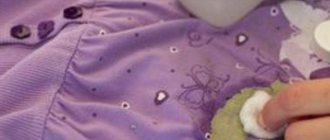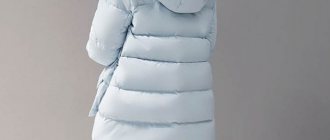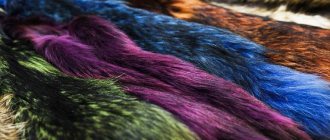Can the coat be washed?
Any outerwear needs to be washed after some time, and this can be done. Depending on the material of the coat and the method of its manufacture, the possibility of washing in a machine or only by hand is determined. To do this, manufacturers indicate the available processing methods on the label.
If the label indicates that washing is prohibited, as indicated by the crossed out icon, you will have to resort to dry cleaning.
The designation with a basin and a hand lowered into the water indicates that hand washing is available. In this case, you should have patience, some knowledge, a soft brush and a large container. The absence of prohibitory signs indicates that you can safely proceed with automatic washing, taking into account other requirements on the tag.
If the product shrinks after washing, what should you do?
The main reasons for coat shrinkage after home washing are:
incorrect choice of detergent;- washing without taking into account the characteristics of the material;
- water hotter than permissible (must be within +30 C);
- sudden temperature changes (when the water during washing is much warmer than during rinsing);
- automatic or manual aggressive spin;
- violation of drying rules.
If mistakes have already been made and the coat has decreased in size, there are ways to return it to its original appearance :
- Method number 1 .
You will need the following solution: for 5 liters of warm water (+15-20 C) you will need 2 tbsp. spoons of soda. Pour enough solution into a basin of suitable size so that the coat is completely submerged. Leave the product for 30 minutes, then rinse thoroughly in water at the same temperature. Lay the item horizontally, without squeezing, and carefully stretch it to the desired size. Repeat gentle stretching during the drying process, and when the material becomes barely damp, steam it well and dry it vertically, hanging it on a hanger. - Method number 2 .
For it you will need the following mixture: for 10 liters of cold water – 6 tbsp. spoons of ammonia and 5 tbsp. spoons of turpentine. Mix the ingredients well and place the coat there for 40 minutes. This solution perfectly softens fabric fibers and makes them elastic. After the procedure, rinse the item thoroughly in cold water and lay it out horizontally. After 10 minutes, pull out the coat, repeating the procedure until completely dry, and then, if necessary, iron through a thin fabric. - Method number 3 .
This method is good for delicate cashmere and fine wool. Stir hair conditioner in cold water (for 10 liters you will need 2 tablespoons). Soak the shrunken coat in this mixture for 25-30 minutes, then rinse in cool water. Lay it out on a horizontal surface, but do not wring out the fabric. Then smooth the product with your hands and begin to stretch it, first in breadth, and then along the fibers. Repeat stretching periodically until drying is complete.
If the coat shrinks slightly, it will be enough to steam it thoroughly. To do this, hang the item on hangers (optimally on a mannequin), and steam with an iron from all sides, working from top to bottom.
How to avoid shrinkage in the future
Fabric deformation such as shrinkage negatively affects the appearance of the product and is not easy to eliminate. The advantage of dry cleaning is that they return the product to the desired size using an inflatable mannequin .
The item is put on it and, as it dries, the required amount of air is added, after which it is thoroughly steamed.
In household use, a simple mannequin is a rarity. Therefore, in order to avoid future shrinkage of the coat, you should not act at random when washing, but carefully study the features of the material from which this model is made.
Useful information about washing outerwear is presented in this section.
What to do to prevent clothes from losing their shape and shrinking?
Regardless of the type of washing, it is important to adhere to a number of rules that apply to any coat materials. This will not only provide a good result, but will also preserve the original appearance of the clothes. When washing by hand, do not wrinkle or rub the fabric too much. It is better to use a soft brush and lay the coat on a flat surface. When using a washing machine, wash only in the delicate cycle.
Temperature
As a rule, the washing temperature is indicated on the product tag. In the case where there is no tag, there is a single rule - the water should be +30...+40°C.
Detergent
To ensure the safety of the fabric, it is important to choose the right washing powder. Targeted liquid products (for colored or white products, natural or synthetic) are best suited for such purposes.
There are even liquid detergents that are formulated specifically for designated fabrics.
Proper drying
Another important stage of washing a coat that requires knowledge is drying. To prevent outerwear from losing its original shape and shrinking after washing, it must be dried properly. Under no circumstances should you speed up the process using an automatic dryer, hair dryer or iron.
To ensure a positive result, you should use hangers of the appropriate size, on which the coat is hung, all folds and folds are straightened, buttons are fastened and left to dry away from direct sunlight and artificial heat sources.
It is better not to hang wool and cashmere coats, as they tend to stretch. Such products are spread on a flat surface covered with a terry towel. We also lay a fabric that absorbs moisture well on top. As the towels become damp, change them and leave the item to dry completely.
Drying a coat after washing
After washing, it is better to dry any clothes in the open air, for example, on the balcony. If it is not possible to dry things outside, you need to find a room with good ventilation.
To dry the coat, hang it on hangers: this way it will not lose its shape and maintain a presentable appearance. It is not advisable to dry items near open heat sources: stoves, stoves, radiators. This drying method may damage the product.
A coat made of bologna fabric with various fillings can be dried like any other clothing.
Preparatory stage
There are a number of basic recommendations on how to properly wash coats made from various fabrics. First, begin preparing the product for the cleaning procedure:
- Fur parts (cuffs and collar and hood with fur trim) are removed. If the manufacturers have not provided for this, you will have to carefully rip it off. Faux fur inserts do not need to be removed.
- Decorative elements and large metal parts must be removed so that the fabric is not damaged in the process.
- For delicate natural fabrics, you need to choose a special detergent, which is intended not only for washing, but also for softening and antistatic.
- It is necessary to carefully inspect the pockets. You should take all of them out.
- If there are specific stains (coffee, tea, grass, etc.), they must be treated with anti-stain products immediately before washing.
Preparing for washing
Before you start cleaning, you should familiarize yourself with the symbols on the label. With their help, the manufacturer gives recommendations for care and use, and also indicates the composition of the material. Based on this, you need to select suitable detergents, washing mode and ironing capabilities.
In the future, it is worth taking out all the items from your pockets and unfastening the fur. If possible, remove metal elements and lubricate non-removable ones with glycerin so that they do not rust when exposed to moisture.
Before washing, you should first go over the entire surface with a soft bristle brush or vacuum using a special attachment. This will remove the top layer of dust. If there are stains, it is recommended to treat them with a stain remover, depending on the type of fabric and its color.
How to wash a cashmere coat?
You can wash a cashmere coat at home if you follow the manufacturer’s exact recommendations indicated on the tag. Any deviation from the rules entails irreversible harm: the item loses its shape, wrinkles, and the floors curl up.
Most products are strengthened by adding durable synthetic threads in different proportions. It is important to know exactly what fibers the material is made of. This will determine whether a cashmere coat can be washed.
The WS 100% mark indicates the purity of the fabric. It is not recommended to wash this item yourself; only dry cleaning is acceptable.
What and how to wash?
Before you start standard washing, it is better to first try treating the fabric dry, slightly dampening only the problem areas. Often a surface treatment will completely clean the coat. For this purpose, soft brushes, rollers or rollers are used. They need to work carefully, without using force.
If you decide to wash outerwear, you should definitely choose the right detergent, which is designed specifically for cashmere. This could be shampoo or gel. At the same time, you should not forget about the conditioner, which will soften both the water and the coat itself.
The water temperature should not exceed +30°C. When washing by hand, take a basin of sufficient size, in which the item is first soaked, and then, by lightly wiping the surface of the fabric, dirt and stains are removed. When washing by machine, select the delicate wash mode (if available, for cashmere or wool), and turn off the spin function.
Step-by-step instruction
The first step is to get rid of surface dirt and dust. To do this, hang the coat on hangers and carefully treat the entire surface of the product with a soft brush. Additionally, you can use a roller. You need to comb the fabric in the direction of the pile.
After this, problem areas such as the collar, pockets and cuffs are carefully inspected in order to identify stains that are difficult to remove and greasy areas. If there are any, try to remove them with a brush soaked in a solution of water and stain remover without putting any effort. It is necessary to work gently, giving preference to blotting movements rather than pulling, as careless manipulations can lead to deformation of the material.
Immediately before washing, the coat is turned inside out and all buttons and zippers are fastened. Place the item in a mesh bag, carefully fold it, and wash it according to the rules.
Drying
The drying process plays a big role, since most often improper drying leads to deformation of the product, stretching and twisting of the hem. Cashmere coats should not be twisted; immediately after washing, excess water must be allowed to drain out. This can be done in 2 ways:
- A wet item is hung on hangers over a basin or bathtub.
- On a flat horizontal surface, the coat is laid on a terry towel and covered with the same on top. Sometimes they simply wrap it in a large terry sheet, gently squeezing out excess water.
After this, you should place the item on a clean, dry, flat surface in a well-ventilated area away from heat sources. It's best to leave your coat outdoors. The most important thing is that it is recommended to carefully smooth out all the folds, straighten the parts and wait until the coat is completely dry.
If, after washing, clothes are sent for seasonal storage in a closet, it is necessary to use a breathable cover, the size of which will allow you to avoid creases in the fabric along the entire length. A cover for a white coat is especially important, as dust that gets inside the closet will turn it gray.
Subtleties of washing, taking into account the material
Info! How to wash a coat directly depends on the material that was used to sew it. Many of these things are prohibited from being placed in a washing machine. There are even some that are not allowed to be wet processed at all. This point must be taken into account so as not to spoil the top item of clothing.
If washing is prohibited, you can use carpet shampoo
Drape
In the case of drape clothing, self-cleaning is not advisable. In this case, you cannot wash your coat in a washing machine. When wet, the material shrinks enormously. In addition, a wet product has enormous weight and it is quite difficult to carry out the necessary manipulations with it. Only dry cleaning is allowed. To carry it out, a roller or brush is used. The first tool will easily remove fur and hairs, and the second will help get rid of dust.
At home, dry clean only is recommended.
Speaking about how to wash outerwear by hand, it is worth considering that it is only allowed to immerse it in cool water. The powder used is gentle. Drying is done on a flat horizontal surface. It is extremely important that the room is warm enough and that the room is fully ventilated.
Cashmere
You can wash your coat in a washing machine or by hand. The temperature is set within 20 - 30 degrees. Thanks to this, shrinkage is avoided. The mode can be selected delicate or manual. In this case, spinning is allowed, but only with minimal speed. Conditioner must be used for rinsing.
The coat can be washed in the washing machine using liquid detergents. In such a situation, there will be significantly fewer stains on outerwear. If the spin is done manually, the pressure on the fabric should be as gentle as possible.
Cashmere coats should only be washed on the delicate cycle.
Temperature no higher than 30 degrees and no spin
Woolen
Figuring out how to properly wash a woolen coat is not at all difficult. Such actions should be performed exclusively manually. If a product is placed in a washing machine, its structure and shape may change.
The water temperature should not exceed thirty degrees . Powder is added to it and foamed. After this, the outerwear is soaked for an hour and washed. Particularly contaminated areas should be gently rubbed or treated with a foam sponge.
For woolen products, a manual version is recommended, temperature maximum 30 degrees
After performing such manipulations, the product should be rinsed in clean water at the same temperature. You need to make sure that no streaks remain on the surface. During rinsing, it is also possible to use conditioner intended for hair. Thanks to its use, the item will become softer and wrinkles will be avoided.
At the final stage, the product is gently wrung out. Only minimal effort is required. Twisting the material in this case is strictly prohibited.
Made from synthetics and polyester
These wardrobe items do not cause any difficulties in care. Both hand and machine wash are allowed. However, when immersing a product in household appliances, it is recommended to place it in advance in a bag specially designed for this purpose. The temperature is selected taking into account the information indicated on the tag. As a rule, it varies between 30 – 60 degrees.
The cleaning product is selected taking into account the color of the clothing. If it is dark, it is better to resort to using liquid options that do not leave streaks. In the case of light colors, powder in the form of granules is suitable.
If the product is washed by hand, stretching the material or handling it with brushes is prohibited. Otherwise, the item may lose its original shape. Rinsing is done in cool water. It is recommended to add a little conditioner to it.
Machine washable, temperature 30-60 degrees
Leather
Leather products deserve special attention. It is worth understanding in detail how to properly wash a leather jacket. This material is incredibly sensitive to moisture and mechanical stress. For this reason, manufacturers strongly do not recommend putting such items in a washing machine. True, some housewives still resort to using household appliances, adhering to the following rules:
- setting delicate or manual mode;
- water temperature does not exceed 30 degrees;
- revolutions no more than three hundred;
- use of liquid product.
True, even in this case, washing a leather jacket can lead to irreparable consequences. It is possible that the item will shrink or, on the contrary, will stretch excessively. Therefore, you should resort to machine washing only in extreme cases.
It’s also worth figuring out how to wash a leather jacket by hand. This processing method is considered safer. This is due to the fact that the water remains on the leather jacket for a minimum period of time, the effect on it is gentle and it is possible to adjust the intensity of the movements performed.
How to wash a leather jacket is described in the instructions:
- Initially, clothes are hung on hangers.
- A white leather jacket, like things of any other color, is carefully inspected.
- Initially, large contaminants are removed.
- After this, you should pay attention to individual areas.
- Then you can cope with the task of washing the lining of a leather jacket.
When carrying out such manipulations, it is recommended to use liquid powder, dishwashing detergent, or a solution based on baby soap. You should only completely immerse your jacket in water if it is extremely dirty. After this, the item is rinsed and dried.
Washing a Wool Coat: A Guide
Washing a wool coat at home is quite difficult due to the capriciousness of the material (wool shrinks from water), but it is possible if you have basic knowledge. First of all, you need to familiarize yourself with the tag on the product, from which it will become clear what type of washing can be used and at what processing temperature the item will not lose its shape.
If the coat is made of alpaca or angora, it is better not to risk it and contact a specialist, as there is a high risk of ruining it. In the case when the composition of the fabric is half wool, this probability is reduced to zero. Even machine washable here.
If there is an icon on the tag that allows hand washing, the action algorithm is as follows:
- A liquid or gel product intended for wool products is selected. Dry washing powder must first be completely dissolved in water (preferably hot) and cooled to +30°C.
- They take everything out of their pockets. Fur collars and cuffs are unfastened. Fasten buttons and zippers.
- Depending on the size of the item, use a large basin or bathtub. Dip the coat into the prepared soap solution and let it sit for 5 minutes.
- After time has passed, they begin to gently rub the surface with their palms, without stretching the fabric to the sides.
- You need to remove as much soapy water as possible. To do this, lay the coat on the bottom of the container and gently push out the liquid with your hands.
- The next step is rinsing. It is better to place the item on a smooth surface in the bathtub, providing a slope. Then water from the shower, stroking the fabric from top to bottom with your palms.
- It is necessary to rinse the coat until the water becomes completely clear.
- You cannot twist things out of wool, so at the final stage, lightly squeeze out the maximum amount of water using stroking movements and allow the liquid to drain.
If the tag on the product allows machine washing, the process is simplified:
- Pockets are freed up. Fur, metal and decorative inserts are removed. Buttons or zippers are fastened.
- The coat is folded several times, avoiding creases in the fabric. Place it in a special mesh laundry bag or in a cotton pillowcase. The latter must be sewn up so that the item does not fall out during the washing process.
- Choose a delicate mode if there is no special mode for wool. Set the temperature to +30°C and turn off the spin.
- After washing is completed, take out the product, place it on a flat surface and push out excess moisture with your hands. You can wrap a piece of clothing in a terry towel.
- If possible, it is best to place clothing above the container. This way, in a short time, all the water will drain without harming the fabric.
Another important step is proper drying. Wool becomes quite heavy when wet, so this coat cannot be hung on hangers. It is only allowed to spread it on a flat surface covered with a clean blanket. The item of clothing is spread out, all folds and creases are smoothed out, it is given the desired shape and left to dry completely.
It is not allowed to use any household appliances to speed up the process. The item should be left to dry away from any heat sources in a well-ventilated area or outside.
Basic Rules
To understand how to wash a coat in a machine, you should carefully study the tag that is necessarily present on the clothing. On it, the manufacturer indicates all the important information regarding the care of the outer garment:
- temperature. A sign in the form of a basin with a specific number means which temperature mode should be used;
- iron. If this sign is on the tag, the clothes can be ironed. These steps should be performed exclusively from the wrong side, covering the product with a thin cloth. Thanks to this, it will be possible to avoid possible negative changes. This icon indicates points. If there is only one, ironing is performed at a minimum temperature. Two indicate the average temperature regime, and three indicate the maximum. If there are no dots at all, then there are no restrictions regarding ironing at all;
- circle. If this icon is empty, dry cleaning of varying levels of complexity is allowed. The letter A indicates the possibility of using any solvents. If P is written in the circle, trichlorethylene cannot be used. If the sign is emphasized, the weak mode is applied. The F symbol indicates the need to use weak solvents. In the case of a crossed out circle, dry cleaning is prohibited;
- triangle. If there is a CI designation, as in the case of an empty figure, bleaching is allowed;
- spin A square containing an empty circle indicates the possibility of using any mode. If this sign is crossed out, intense exposure to the product is unacceptable;
- drying. A square without any additional symbols indicates the admissibility of an automated drying process. An image in the form of an envelope is placed in situations where the item may stretch after washing. It is dried in the unfolded state. If the tag has an icon similar to a radiator, the product can be dried in an upright position.
How to wash a coat at home is indicated on the tags. If the washing machine symbol on it is crossed out, the product can only be washed by hand. You should not immerse it in the drum of household appliances. Otherwise, the clothes may be hopelessly damaged.
Is it possible to wash a coat made of drape and how to do it correctly?
Washing a coat at home should only be done as a last resort when the dirt is spread over the entire surface of the product. The most acceptable is partial cleaning of problem areas (edges of pockets, cuffs and collar). To do this, dissolve powder or liquid washing gel in warm water and gently clean the stains with a soft brush.
For convenience and preservation of shape during processing, it is better to place the coat on a horizontal surface. When cleaning is finished, rinse off the soap with clean water and let the item dry.
It is possible to wash a drape coat at home. The process consists of several steps, which are based on the manufacturer's requirements stated on the tag.
First of all, this concerns the type of washing - hand or machine. In the second case, everything is simple - fold the product, place it in a mesh bag, run the delicate mode using a liquid detergent suitable for woolen products. If manual processing is required, the action algorithm is as follows:
- Pour water +30...+40°C into a basin of a suitable size and add a cleaning agent. Dissolve it completely and soak the coat.
- After 5-10 minutes, lightly press the product over the entire area. You can use stroking movements without tension in different directions.
- You should rinse the item, changing the water several times. The process continues until it becomes completely clean, otherwise whitish stains will remain on the fabric.
- Place the washed and rinsed product on a fine wire rack, thus allowing all the water to drain.
- Dry the drape coat on a flat surface, straightening out all the folds. The dryer should be located away from heat sources.
How to clean the fur collar of a winter coat?
A natural fur collar is a wonderful attribute that makes the coat charming. But over time, it loses its presentation. So how to clean such types of collars as:
- Arctic fox . Cleaning can be done with vinegar (250 ml of water and a tablespoon of vinegar). Take a clean cloth, dip it in the solution and wipe it. Then you should go over the collar with a wet sponge.
- From silver fox . Ordinary bran comes to the rescue. They are heated in the oven and then spread over the entire surface of the silver fox collar. Afterwards, the cooled bran is shaken off with the help of hands, the fur is combed and cleaning is completed.
- From a fox. Sand rubbed into the collar will help. After this, you should wait about 20 minutes and brush it off. The vast majority of people clean their fox collar using this method.
As you can see, the cleaning methods are quite simple. You can watch a video that explains in detail how to do this correctly:
How to properly wash a polyester coat?
Polyester outerwear is easier to care for and is not afraid of mechanical processing or intensive washing (both hand and machine). The type of cleaning may depend only on the filler used in the manufacture of clothing:
- A coat made of synthetic padding, with holofiber, isosoft or fibertek fibers, which are artificial and retain their original characteristics well, can be safely placed in the machine and run the delicate mode at low temperatures.
- If the coat is filled with camel hair or other natural materials, you should wash it more responsibly and adhere to the temperature regime. To prevent the fluff from forming into one continuous lump, it is recommended to place special balls or tennis balls in the drum.
Drying of polyester items depends on the size and weight of the filling after it gets wet. If the coat removed from the drum is light and contains virtually no water, you can hang it on hangers and dry it in a well-ventilated area. Natural filler retains moisture more strongly. It is heavy, so it is recommended to place the product on a flat surface and wait until it dries.
The same stages are used if autumn bouclé coats are washed, since the basis of the material for production is synthetic threads. The main thing is not to exceed the temperature level of the water (no higher than +40°C) and spin at low speeds (no more than 600).
Coat care rules
To ensure that your favorite coat always has a presentable appearance and lasts for several years, you should treat it with care and follow the rules of wearing it.
5 useful tips for caring for your product:
- Do not fold, roll, or put coats in drawers or boxes. Over time, the product will lose its shape. The solution to this problem is hangers, which you need to choose the right size and hang your coat on them in a cool place.
- The product should always be dried if it gets wet in the rain. After returning from the street, the coat should be laid out on a large towel so that it absorbs moisture.
- Do not manually remove the pellets from the fabric. If they appear, you can remove them with a special machine.
- You should always read the label information before washing. It indicates the composition of the product and the parameters under which it can be washed.
- As a preventive measure, it is recommended to take your coat to the dry cleaner before and after the season.
Do not forget that coat fabric is expensive and capricious. In order for an item to retain its shape and have a neat appearance, it requires careful care and careful wearing.
Drape coat: how to wash it correctly?
Many housewives wonder whether a drape coat can be washed. The answer is of course yes. The main thing is to follow the basic recommendations for cleaning it. If the product is dirty only in certain places (sleeves, collar), it is better to wash them separately. To do this you need to do the following:
- prepare a solution (not strong) from detergent for washing clothes made of wool, apply it to the contaminated areas of the fabric;
- lightly rub the stains with a brush and wash the entire coat with a washcloth;
- Rinse the item and hang it to dry.
If the entire coat is dirty, wash it in the same way as a cashmere coat, having previously studied the washing conditions (on the label):
- water temperature – about 30 degrees (no more);
- soaking time – 10-15 minutes;
- cleaning contaminated areas of fabric is carried out with a soft brush or washcloth;
- Rinse clothes in cold water until soap stains completely disappear.
Drape items are not twisted or wrung out after washing. The water should drain naturally. Dry the product on a hanger at room temperature or on the balcony (during the warm season).
What not to do when washing?
Before you start cleaning your outerwear at home, you need to know what is strictly forbidden to do, otherwise your favorite item may become unsuitable for further wear.
Unacceptable actions:
- the use of aggressive components to remove old stains;
- ignoring the manufacturer's care recommendations indicated on the label;
- the use of bleach, which destroys the structure of natural fibers;
- temperature exceeding 30-40 degrees;
- enhanced spin;
- washing at the same time with other things.
It is quite possible to refresh your outerwear at home without resorting to dry cleaning, but every detail is important in the process. Ignoring basic recommendations can negatively impact natural fibers. After washing, it is also important to dry the clothes in a well-ventilated area, otherwise the unpleasant smell of dampness can significantly spoil the final result.











